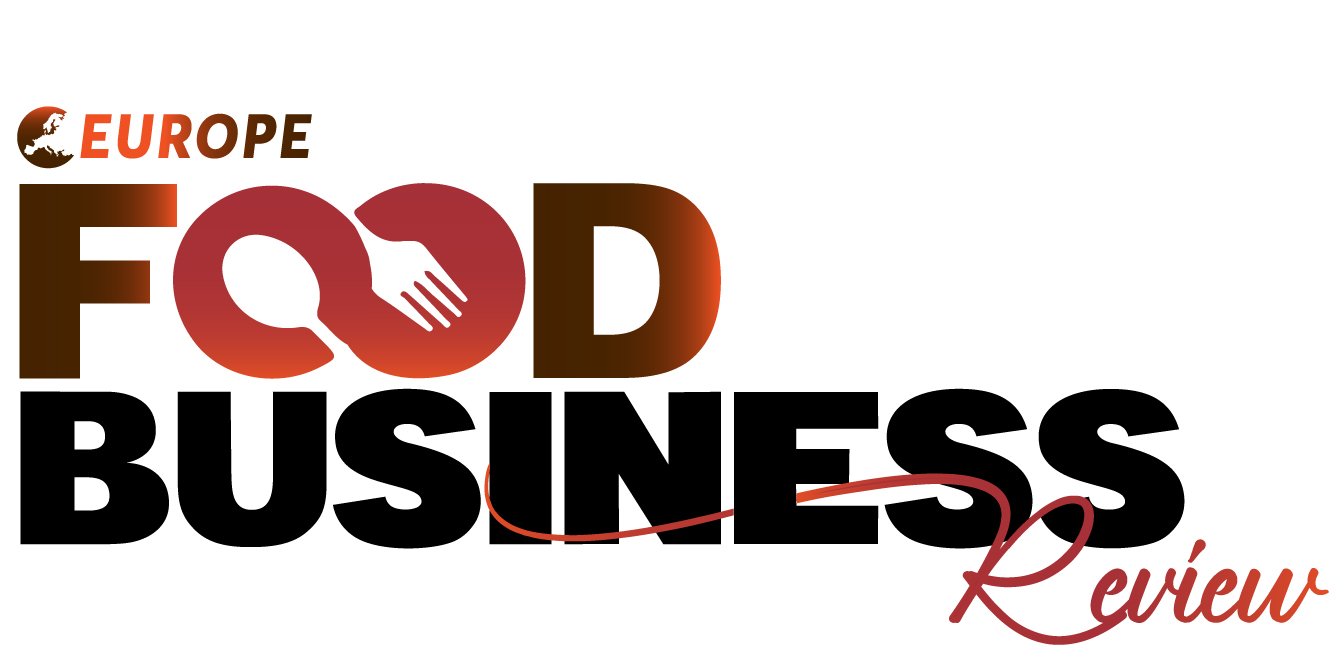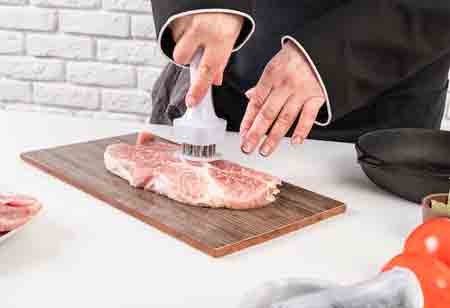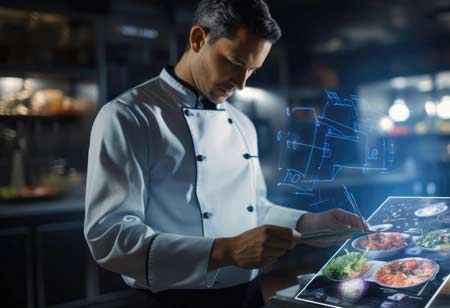\\\\ Top Food And Beverages Marketing Firms \\\\
\\\\\\\\ Top Food And Beverages Marketing Firms \\\\\\\\
-
Crew Marketing Partners
Crew Marketing Partners is a strategic and creative agency dedicated to food and beverage brands. It focuses on building meaningful partnerships, offering tailored marketing solutions that address industry challenges, foster innovation, and ensure sustainable growth for their clients.
-
The Food Group
A premier food and beverage marketing agency, The Food Group combines culinary expertise with innovative strategies. It specializes in connecting brands with consumers through creative storytelling, trend analysis, and impactful campaigns, ensuring their clients thrive in the competitive food industry.
More in News
Innovations Driving Global Meat Distribution Growth
Wednesday, October 08, 2025
FREMONT, CA: Technological advancements, shifting consumer preferences, and a growing emphasis on sustainability are transforming the meat distribution sector. These changes impact how meat is sold and consumed, while also promoting international growth in the industry. Consumers are becoming more selective about their meat purchases, prioritizing products that offer superior flavor, texture, and nutritional value, such as heritage breeds, organic poultry, and grass-fed beef. In response to these trends, meat wholesalers are emphasizing sustainable agricultural practices and animal welfare by sourcing high-quality products and establishing relationships with specialty producers. The prominent trend in the meat distributors industry is the rising demand for high-quality and specialty meats. The trend drives growth in the premium meat segment and encourages innovation in meat production and distribution. Meat distributors are adopting sustainable practices, such as sourcing from farms that follow humane treatment standards, reducing carbon emissions, and minimizing waste. Innovations enhance supply chain transparency, efficiency, and traceability. Blockchain technology, for example, allows for secure and transparent tracking of meat products from farm to table, ensuring food safety and authenticity. IoT devices can monitor storage conditions and track shipments in real time, reducing spoilage and ensuring optimal product quality. The growth of e-commerce and direct-to-consumer models transforms how meat is distributed and purchased. Meat distributors are capitalizing on this trend by developing robust online sales channels, offering subscription services, and providing detailed product information and cooking tips. Globalization creates new opportunities for meat distributors to expand their markets and reach new consumers. Meat distributors explore these markets by establishing local partnerships, adapting products to regional tastes and preferences, and navigating regulatory environments. Advancements in cold chain logistics and international trade agreements facilitate the global movement of meat products, enabling distributors to tap into new growth opportunities. Health and wellness trends influence consumer choices and drive demand for leaner, healthier meat options. Consumers seek products free from antibiotics, hormones, and additives and those with higher nutritional value. Meat distributors are responding by offering a more comprehensive range of products that cater to health-conscious consumers, such as lean cuts, organic meats, and products fortified with omega-3 fatty acids. The focus on health and wellness meets consumer demand and encourages product development and marketing innovation. The importance of cold chain infrastructure in maintaining the quality and safety of meat products cannot be overstated. Investment in advanced refrigeration, storage, and transportation technologies is critical for ensuring that meat products remain fresh and safe from production to consumption. Meat distributors are upgrading their cold chain infrastructure to meet increasing demand, reduce spoilage, and comply with stringent food safety regulations. The investment is essential for maintaining consumer trust and driving growth in the industry. The meat distributors industry is experiencing dynamic changes driven by consumer preferences, technological advancements, sustainability, and globalization. Meat distributors can enhance operations, meet evolving market demands, and drive global growth. The industry's future will be shaped by distributors' ability to innovate, adapt, and deliver high-quality, sustainable, and convenient meat products to consumers worldwide.
Kitchen Care: The Key to Smooth Commercial Operations
Tuesday, October 07, 2025
Fremont, CA: In the fast-paced environment of commercial kitchens, maintaining equipment and facilities is crucial for ensuring efficiency and compliance. Regular kitchen maintenance protects staff and customer health, enhances operational efficiency, and safeguards a business's reputation. Ensuring Food Safety and Compliance One of the top priorities in any commercial kitchen is the health and safety of both staff and customers. Regular maintenance of kitchen equipment plays a vital role in minimizing contamination risks. For example, keeping refrigeration units at optimal temperatures helps avoid spoilage of perishable items, while properly cleaning hoods, vents, and grease traps prevents harmful bacteria and mold growth. Well-functioning dishwashers, sinks, and sanitation equipment are essential for upholding hygiene standards and reducing the risk of foodborne illnesses, which can lead to costly health violations and reputational damage. Proactive Maintenance for Operational Efficiency Commercial kitchens must adhere to strict health and safety regulations, and routine maintenance is key to ensuring compliance with these local, state, and federal guidelines. Regular inspections allow early identification of potential hazards such as gas leaks, electrical faults, or malfunctioning fire suppression systems, thereby reducing the risk of costly fines, legal issues, or operational disruptions. A well-maintained kitchen operates seamlessly, with equipment performing at peak efficiency. By addressing minor problems before they escalate, maintenance helps minimize downtime, improve workflow, and enhance overall productivity. Simple tasks like sharpening knives and servicing stovetops can significantly speed up meal preparation, enabling kitchen staff to work more efficiently. Cost-Effective Solutions Through Preventive Maintenance While routine kitchen maintenance may appear trivial at first glance, it can yield significant savings in the long run. Preventive maintenance is often far less expensive than dealing with major repairs or replacing broken equipment. Regular servicing and inspections extend the lifespan of costly appliances like refrigerators, ovens, and dishwashers, ensuring their longevity and reducing the risk of costly breakdowns. Moreover, maintaining equipment contributes to energy efficiency. For instance, a neglected air conditioning unit or walk-in freezer could consume excess energy, leading to inflated utility bills. Keeping everything in top shape not only ensures optimal performance but also lowers operating costs, ultimately benefiting the bottom line. Emphasizing regular kitchen maintenance can lead to smoother operations, improved safety, and significant long-term savings, making it an essential practice for any commercial kitchen.
Best Practices for Efficient Online Food Delivery Management
Tuesday, October 07, 2025
Fremont, CA: The online food delivery market in Europe is experiencing growth due to increasing smartphone and internet usage, changing consumer lifestyles, and the rise of delivery platforms and cloud kitchens. This environment offers both significant opportunities and challenging obstacles for businesses. However, with determination and resilience, these challenges can be addressed, leading to even greater success. Optimising Last-Mile Delivery for Speed and Efficiency Last-mile delivery remains the most complex and cost-intensive segment of the supply chain, particularly within Europe’s diverse urban environments—from narrow historic streets to densely populated modern cities. To address these challenges, companies must leverage advanced technologies and operational strategies. One key solution is AI-powered route optimisation software that accounts for real-time traffic data, vehicle capacity, delivery time windows, and increasingly common low-emission zones in cities such as London, Paris, and Amsterdam. This reduces fuel consumption, minimises idle time, and ensures on-time deliveries. Complementing this, real-time tracking systems can enhance customer satisfaction by offering live GPS updates and transparent estimated delivery times, all accessible via intuitive mobile applications. Driver enablement is another critical component. Equipping personnel with apps that provide optimised routes, support digital payments, and offer proof of delivery (e.g., photo confirmations and OTP verification) significantly improves efficiency. Continuous training on customer service, food safety, and compliance with local regulations is essential. Moreover, batching nearby orders and adopting zone-based delivery models enable faster service in dense areas by leveraging driver familiarity with specific routes. The use of strategically located micro-fulfilment centres and dark stores—facilities dedicated exclusively to online orders—further accelerates order preparation and local deliveries. Prioritising Customer Experience and Retention In an increasingly saturated market, retaining loyal customers is more cost-effective and sustainable than acquiring new ones. Prioritising customer experience through personalisation, user-friendly design, and responsive support is crucial to achieving long-term success. Data-driven personalisation is a powerful tool that allows platforms to recommend products based on past purchases, dietary preferences (e.g., vegan or gluten-free), and even special occasions such as birthdays. This approach, backed by solid data, can significantly boost user engagement and make the audience feel that their decisions are well-informed. Exceptional customer service, delivered through live chat, email, and phone support, builds trust and enhances brand loyalty. Prompt resolution of issues and proactive communication demonstrate reliability. Loyalty programs offering rewards, discounts, or exclusive perks for repeat customers, along with gamified elements and subscription models, further encourage repeat business. Collecting and acting upon customer feedback fosters a culture of continuous improvement. Additionally, offering flexible delivery slots caters to diverse consumer schedules and enhances overall convenience. Embracing Sustainability for Competitive Advantage Sustainable packaging—such as compostable, recyclable, or reusable materials made from bamboo, sugarcane, or other eco-friendly sources—reduces environmental impact. Initiatives like “Green Packaging Badges” can incentivise partner restaurants and signal responsible choices to customers. The adoption of electric vehicles, including e-bikes and electric vans, supports emissions reduction goals in line with the EU Green Deal. Route optimisation not only improves efficiency but also helps minimise carbon emissions by reducing unnecessary mileage. Food waste reduction strategies, including menu optimisation, composting, and inventory management, can significantly reduce waste when implemented in collaboration with restaurants. Encouraging local sourcing further reduces the carbon footprint while supporting regional economies. Strategic Partnerships and Business Diversification Long-term resilience in the food delivery sector depends on strategic partnerships and diversified service offerings. Collaboration enables broader reach, cost efficiencies, and greater customer satisfaction. Forming strong partnerships with a wide array of restaurants, including those offering organic, vegan, or gourmet menus, ensures a broad selection for customers. Investing in cloud kitchens can provide a scalable, cost-effective means of expanding into new regions and cuisines without the overhead of traditional restaurants. Expanding services into online grocery or other on-demand deliveries allows platforms to leverage existing logistics infrastructure and tap into new revenue streams. Subscription models—targeted at both consumers and restaurants—can offer discounts, data insights, and tools that foster loyalty while creating consistent income. The European online food delivery market is characterised by robust growth, fierce competition, and evolving consumer and regulatory demands. The coming years will see continued innovation, and companies that prioritise these best practices, especially technology adoption, will be best positioned for long-term success.
Seamless Cold Chain Solutions for Superior Freshness
Tuesday, October 07, 2025
Fremont, CA: Driven by increasing demand, cold chain food logistics is advancing, supported by innovative technologies and effective freight management solutions. Cold chain logistics tends to receive less attention than other forms of food logistics. However, it presents more significant challenges and risks, underscoring the necessity for distributors and all participants in the supply chain to refine their logistics strategies. Cold chain logistics is a distinct sector within food logistics that aims to ensure the secure transportation of perishable food items. This process guarantees that the products are kept at the appropriate temperature throughout each phase of the supply chain. This particular logistics sector necessitates meticulous planning, cutting-edge technology, precise management, and some of the most sophisticated packaging and refrigeration solutions available. An in-depth examination reveals the unique challenges faced by this industry, as well as the innovative technologies that are facilitating opportunities for growth on a global scale. The primary issue in transporting perishable food items is ensuring the safety and quality of the products throughout the shipping process. However, various factors complicate this task within cold chain logistics. They are: Condensation and Temperature Changes Due to Faulty Equipment: A prevalent issue encountered is essential equipment failure, even if only briefly. Fluctuations in temperature can lead to risks such as freezer burn, condensation, and damage to products. Sudden equipment malfunctions represent a significant concern within the logistics management framework due to the potential damage that can occur in minutes. The most effective strategy to mitigate these risks is to ensure the availability of backup support to monitor and maintain precise temperature levels consistently. Collaborating with reputable cold chain logistics firms, particularly those equipped with cutting-edge technology for product oversight, can provide valuable assistance. Human Errors: Errors in refrigerated logistics frequently stem from human oversight. Only highly skilled professionals should actively manage logistics. Inefficiencies in operations or inadequate equipment management can significantly increase the risk of food product damage. Training on appropriate handling techniques and best practices in cold product management is vital for addressing these issues. Furthermore, technological innovations that automate various tasks and processes may substantially support operational management. High Costs: Cold chain logistics requires significant capital investment, which entails substantial expenses for specialized equipment, refrigerated transportation, temperature monitoring systems, and energy usage. The upkeep of cold storage facilities and refrigerated vehicles, particularly those adhering to rigorous standards, can incur considerable costs. These elevated operational expenses may pose challenges for smaller enterprises, hindering their ability to offer competitive pricing, especially in low-margin sectors such as the food industry.
Tech-Driven Dining: Enhancing Efficiency and Customer Experience
Monday, October 06, 2025
The restaurant industry stands at the forefront of a digital transformation revolutionizing its operational landscape and customer engagement strategies. As consumer preferences shift toward more efficient, personalized, and sustainable dining experiences, restaurants must integrate cutting-edge technologies to stay competitive. The industry is streamlining operations and enhancing overall guest satisfaction by leveraging digital ordering platforms and AI-powered customer interaction tools. This technological evolution is essential for navigating the complexities of a market shaped by dynamic consumer behaviors, labor shortages, and rising operational costs. Embracing these advancements is vital for restaurants aiming to thrive in an increasingly challenging environment. Enhancing Efficiency and Customer Experience The restaurant industry is experiencing a surge in the use of mobile applications, digital menus, and self-service kiosks. These tools streamline the customer ordering process and offer an enhanced level of personalization. Customers can now easily customize their orders, bypass long queues, and have a more direct line to restaurant management through mobile apps. These digital ordering platforms have gained traction, particularly in fast-casual dining and quick-service establishments, where speed and convenience are critical. Self-ordering kiosks, once a novelty, have become a standard in many chains, enabling restaurants to handle higher volumes of customers while reducing human error. AI-driven technology is also making its mark on restaurant operations. Intelligent voice assistants are revolutionizing how customers make reservations or inquire about menu items. These systems, often powered by AI, can take reservations, respond to inquiries, handle routine tasks, and assist with order processing. By automating these processes, restaurants can offer more seamless, efficient service, ultimately improving customer satisfaction. Cloud-based technology allows restaurants to manage their day-to-day operations better. From inventory tracking to sales forecasting, cloud-based solutions allow restaurant operators to stay ahead of potential supply shortages, optimize staff scheduling, and monitor real-time performance metrics. This data-driven approach helps streamline processes, enhance cost efficiency, and improve decision-making, contributing to overall profitability. Navigating Operational Challenges with Technological Innovation The restaurant industry is grappling with labor shortages, a challenge exacerbated by the lasting effects of the COVID-19 pandemic. With a reduced pool of skilled workers in kitchens, front-of-house, and management, restaurants increasingly turn to automation to maintain service levels. Automated ordering systems, kitchen display systems, and robotic food preparation are becoming essential tools in easing the burden on staff and ensuring consistent service during peak times. These technologies help improve operational efficiency and alleviate the strain on human resources, assisting establishments in maintaining quality service even with limited manpower. For some operators, purchasing and installing advanced systems and the necessary training can be prohibitive. Many restaurants face the difficult task of balancing the need for technological upgrades with rising operational costs, including food and labor expenses. In response, more affordable, scalable technological solutions are emerging, allowing restaurants to grow at their own pace. Cloud-based point-of-sale (POS) systems and integrated software platforms are replacing outdated legacy systems, streamlining operations, reducing overhead, and enabling better customer engagement. The restaurant industry must navigate increasingly stringent health and safety regulations. Technology is crucial in helping businesses meet these standards while improving customer convenience. Contactless payment systems and digital menus reduce physical interactions, promoting safer dining experiences. Technology-enabled kitchen management systems ensure food safety and operational efficiency by accurately tracking orders and managing ingredients. By embracing these technological solutions, restaurants can enhance their compliance and ability to provide a safe, efficient, and customer-friendly environment. Seizing Opportunities for Growth and Advancements The restaurant technology sector is brimming with growth potential, driven by innovations that unlock new revenue streams and deepen customer engagement. Data analytics is one such area that allows restaurants to gather insights from customer behavior. By analyzing this data, restaurants can offer personalized promotions, tailor menu offerings, and refine pricing strategies. AI-powered tools also help predict demand, enabling restaurants to adjust staffing and inventory levels, reducing waste and improving profitability. As customers increasingly seek environmentally friendly options, technology enables restaurants to adopt energy-efficient kitchen appliances, waste reduction systems, and sustainable sourcing tools. These technologies lower a restaurant's environmental footprint and help reduce operational costs, providing a competitive edge in a growing market of eco-conscious consumers. Technologies like augmented reality (AR) and virtual reality (VR) offer unique ways to engage customers, from interactive menus to virtual cooking experiences. These innovations create memorable experiences that resonate with tech-savvy diners, enhancing brand loyalty. The increase in delivery platforms and ghost kitchens offers a valuable opportunity for growth. By embracing third-party delivery services and operating cloud kitchens, restaurants can expand their reach and scalability without the overhead costs tied to traditional dine-in models.
Enhancing Food Flavor and Texture Through Oils and Fats
Monday, October 06, 2025
FREMONT, CA: Oils and fats, sourced from both plants and animals, play a vital role in cooking and nutrition. It provides essential nutrients, enhances flavors, and improves the texture of food. Beyond their dietary importance, these fats have various industrial applications. However, while oils and fats offer many benefits, they can also pose health and environmental risks if misused or consumed in excess. Pros: Nutritional Benefits and Culinary Versatility Source of Essential Fatty Acids: Oils and fats are rich sources of essential fatty acids, like omega-3 and omega-6, which the body cannot produce independently. These fats are critical for reducing inflammation, maintaining robust cell membranes, and enhancing mental performance. Energy Source: Fats are rich energy sources since they have more than twice as many calories per gram as proteins or carbohydrates. Lipids have a high energy density, making them essential for meeting daily caloric requirements and sustaining physical activity. Enhances Flavor and Texture: In cooking, oils and fats contribute to the sensory appeal of food by improving flavor, imparting richness, and creating desirable textures. Whether used for sautéing, frying, baking, or salad dressings, oils and fats are integral to creating diverse and satisfying culinary experiences. Nutrient Absorption: Certain vitamins, such as A, D, E, and K, are fat-soluble, requiring fats for absorption and transportation within the body. Incorporating healthy fats into meals helps ensure efficient absorption of these essential nutrients. Versatility in Cooking Methods: The optimal cooking methods for different types of oil depend on their smoke point. Extra virgin olive oil and other oils with lower smoke points are better used in salad dressings and low-heat cooking; avocado and peanut oils, however, have more excellent smoke points and are ideal for frying. Cons: Health Considerations and Environmental Impact High Caloric Density: Even while fats are an essential source of nutrients and energy, if consumed in excess and are not balanced with overall calorie intake and physical exercise, they can cause obesity and weight gain. Saturated and Trans Fats: Certain fat sources, especially those derived from animal products and partially hydrogenated oils, contain high concentrations of saturated and trans fats. Excessive consumption of these fats can elevate cholesterol levels and heighten the likelihood of cardiovascular ailments. Environmental Impact: The production of oils, especially palm oil and soybean oil, has raised concerns about deforestation, habitat destruction, and biodiversity loss in regions where these crops are cultivated. Sustainable sourcing practices and certifications are crucial for mitigating these environmental impacts. Processing Methods: Oil refining and processing can diminish their nutritional quality by reducing levels of beneficial compounds such as antioxidants and phytochemicals. Opting for minimally processed or cold-pressed oils preserves more of their natural nutrients. Allergies and Sensitivities: Some people may be allergic to or sensitive to particular oils, including soybean or peanut oil. It's critical that those with known allergies carefully read labels and avoid oils that could cause negative responses. Balancing Consumption for Health and Sustainability To harness the benefits of oils and fats while mitigating potential drawbacks, consider the following tips: Choose Healthy Fats: Choose unsaturated fats; these have been connected to lowering cholesterol and decreasing the risk of heart disease. For instance, these fats can be found in olive oil, avocado, canola, almonds, and seeds. Moderation is Key: Consume fats in moderation and maintain a balanced diet rich in various nutritious foods, including fruits, vegetables, lean meats, and whole grains. Read Labels: Pay attention to labels and choose oils and fats that are minimally processed and free from harmful additives or trans fats. Consider Sustainability: Select oils labeled sustainably sourced or certified by groups such as the Roundtable on Sustainable Palm Oil (RSPO) to support sustainable practices.















